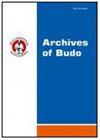身体平衡抗扰能力评价方法“旋转试验”验证程序
IF 1.5
3区 医学
Q3 SPORT SCIENCES
引用次数: 55
摘要
身体平衡干扰耐受能力(BBDTS)可以定义为在跌倒危险情况下保持垂直姿势的能力。本研究的目的是“旋转测试”(RT)作为BBDTS测量工具的适当性和可靠性。材料与方法:RT包括6个任务(连续跳跃,身体360°交替左右旋转)。总体结果是六个任务的总和,包括0到18个规定的点。面向标效度(并发效度和预测效度);内容效度;建构效度一直被认为是衡量恰当性的主要标准。RT的信度基于“测试-重测试”公式。在验证过程的所有阶段,我们检查了1398名年龄从6岁到60岁的人。结果:RT个体结果由0到18分组成,然而在均匀组中,平均RT结果从0.33到11.06分不等。RT满足工具的适当性和可靠性的方法学标准,间接表明负责平衡和姿势控制的身体机制的质量。RT的信度已被确定为高(“test-retest”相关性从0.828到0.848不等)。结论:RT对改变BBDTS的因素很敏感,尤其是与长期训练相关的适应性变化,以及身体当前状态的影响和/或运动动作条件的突然变化。因此,RT可以广泛应用于康复、健康相关训练、运动控制(运动、体育等)、军队、警察、应急服务等方面的选拔过程。本文章由计算机程序翻译,如有差异,请以英文原文为准。
The method to evaluate the body balance disturbation tolerance skills – validation procedure of the “Rotational Test”
Background Body balance disturbation tolerance skills (BBDTS) can be defined as the ability to maintain the vertical posture in the circumstances of the fall hazard. The aim of this study is appropriateness and reliability of ‘Rotational Test’ (RT) as BBDTS measurement tool. Material & Methods: RT consists of six tasks (consecutive jumps with body rotation of 360° alternately to the right and to the left). The overall result is the sum of the six tasks and includes 0 to 18 stipulated points. Criterion-oriented validity (concurrent validity and predictive validity); content validity; construct validity have been assumed to be the main criteria of appropriateness. Reliability of the RT is based on the ‘test-retest’ formula. Following all phases of the validation process we have examined 1398 people aged from 6 to 60 years. Results: RT individual results consisted of 0 to 18 points, however in homogeneous groups the average RT result varied from 0.33 to 11.06 points. RT satisfies methodological criteria of appropriateness and reliability of a tool which indirectly indicates the quality of the body mechanisms responsible for balance and postural control. Reliability of the RT has been determined as high (‘test-retest’ correlation varies from 0.828 to 0.848). Conclusions: RT is sensitive to the factors modifying BBDTS – especially adaptive changes related to a long-term training as well as the influence of the current state of the body and/or a sudden change in the conditions of motor action. Thus, RT can be widely used in rehabilitation, health-related training, motor control (sport, physical education, etc.), the selection process in the army, police, emergency services, etc.
求助全文
通过发布文献求助,成功后即可免费获取论文全文。
去求助
来源期刊

Archives of Budo
SPORT SCIENCES-
CiteScore
2.80
自引率
47.60%
发文量
0
审稿时长
>12 weeks
期刊介绍:
Archives of Budo is an international peer reviewed journal publishing articles on various aspects of the sports sciences covering education and research in martial arts and combat sports, and related areas like biomechanics, kinesiology, medicine, psychology, sociology, technologies of sports equipment, research in training, selection, performance, survival, and other interdisciplinary perspectives.
Archives of Budo editors endorse the principles embodied in the Helsinki Declaration and expect that all research involving humans has been performed in accordance with these principles. All human studies must have been approved by the investigator''s Institutional Review Board. A copy of the relevant documentation should be included with the manuscript. Furthermore Archives of Budo follows the ICMJE''s Recommendations for the Conduct, Reporting, Editing and Publication of Scholarly Work in Medical Journals.
Archives of Budo provides free, immediate and permanent online access to the full text of all articles distributed under the terms of the Creative Commons Attribution Non-commercial License http://creativecommons.org/licenses/by-nc/4.0), which permits use, distribution, and reproduction in any medium, provided the original work is properly cited, the use is non-commercial and is otherwise in compliance with the license.
 求助内容:
求助内容: 应助结果提醒方式:
应助结果提醒方式:


